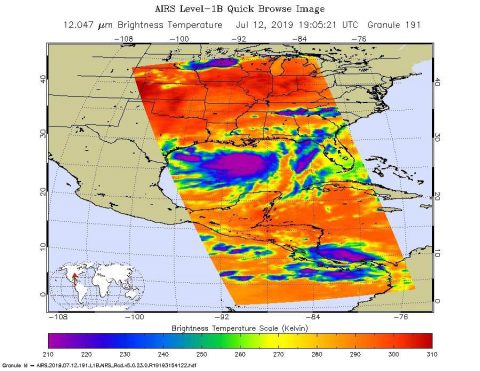 Pasadena, CA – On Friday, July 12th, 2019, at around 2:00pm local time, NASA’s Atmospheric Infrared Sounder (AIRS), aboard the Aqua satellite, captured imagery of Tropical Storm Barry in the Gulf of Mexico. According to the National Hurricane Center, Barry is expected to make landfall over the Louisiana coast on Saturday, likely as a hurricane.
Pasadena, CA – On Friday, July 12th, 2019, at around 2:00pm local time, NASA’s Atmospheric Infrared Sounder (AIRS), aboard the Aqua satellite, captured imagery of Tropical Storm Barry in the Gulf of Mexico. According to the National Hurricane Center, Barry is expected to make landfall over the Louisiana coast on Saturday, likely as a hurricane.
In the infrared AIRS image, the large purple area indicates very cold clouds that have been carried high into the atmosphere by deep thunderstorms. These clouds are associated with heavy rainfall. Warmer areas with shallower rain clouds are shown in blue and green. And the orange and red areas represent mostly cloud-free air.

At the time the image was captured, Barry had maximum sustained winds of 65 mph (105 kph). When the storm reaches maximum sustained winds of 74 mph (119 kph), it will be upgraded to hurricane status.
The National Hurricane Center notes that the slow movement of the storm will result in long periods of heavy rain, dangerous storm surge and flooding in parts of the central Gulf Coast into the Lower Mississippi Valley.
AIRS, in conjunction with the Advanced Microwave Sounding Unit (AMSU), senses emitted infrared and microwave radiation from Earth to provide a three-dimensional look at Earth’s weather and climate. Working in tandem, the two instruments make simultaneous observations down to Earth’s surface.
With more than 2,000 channels sensing different regions of the atmosphere, the system creates a global, three-dimensional map of atmospheric temperature and humidity, cloud amounts and heights, greenhouse gas concentrations and many other atmospheric phenomena.
Launched into Earth orbit in 2002, the AIRS and AMSU instruments fly onboard NASA’s Aqua spacecraft and are managed by NASA’s Jet Propulsion Laboratory in Pasadena, California, under contract to NASA. JPL is a division of Caltech.
More information about AIRS can be found at:



